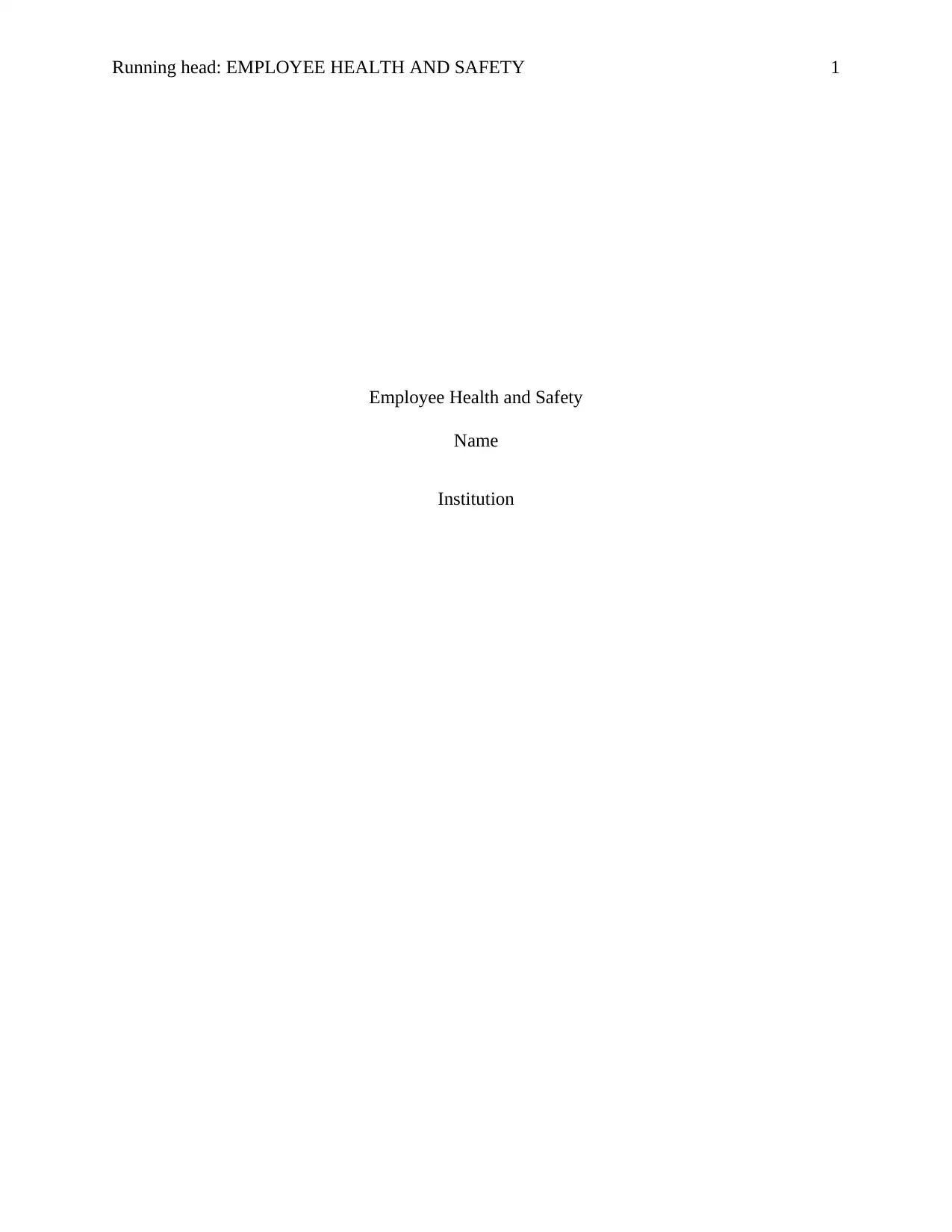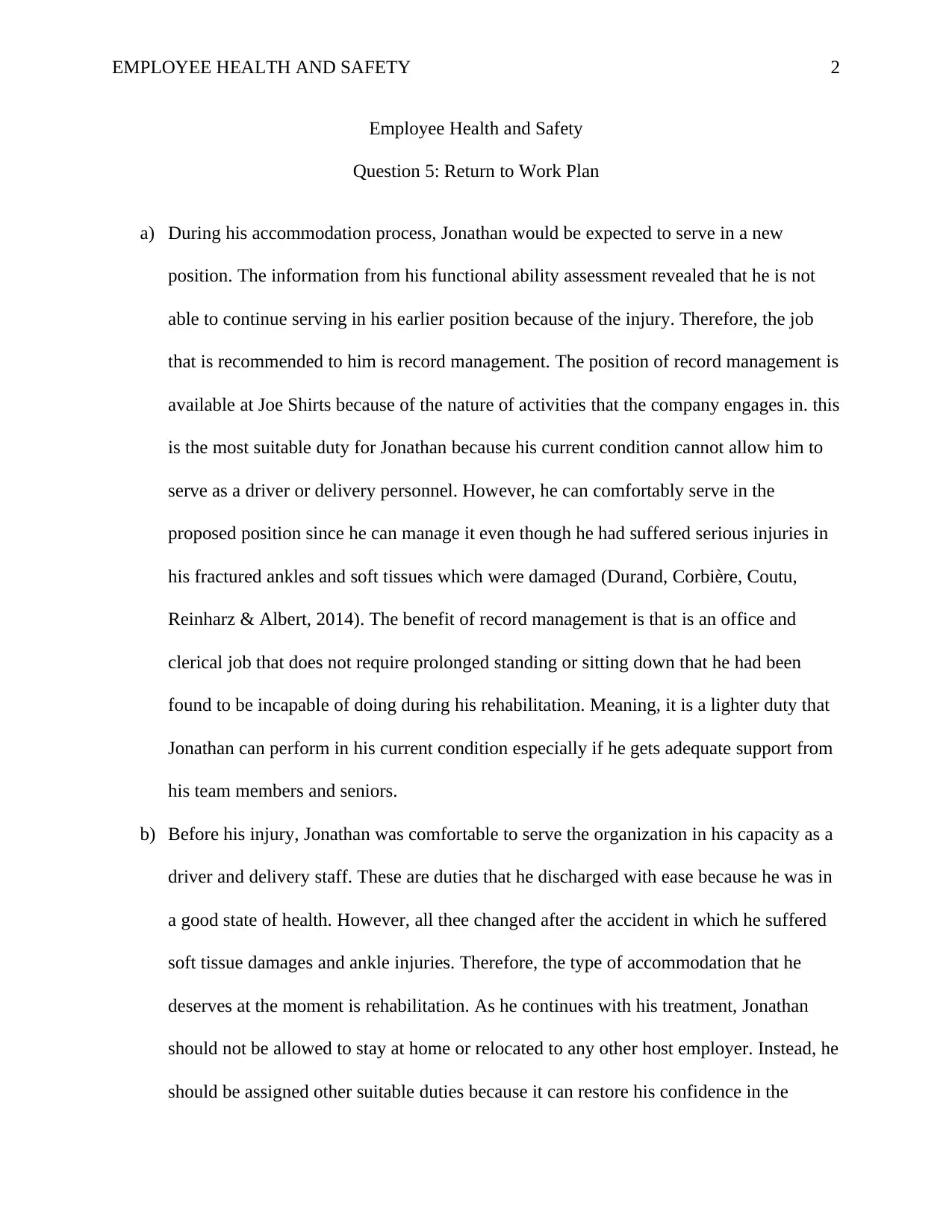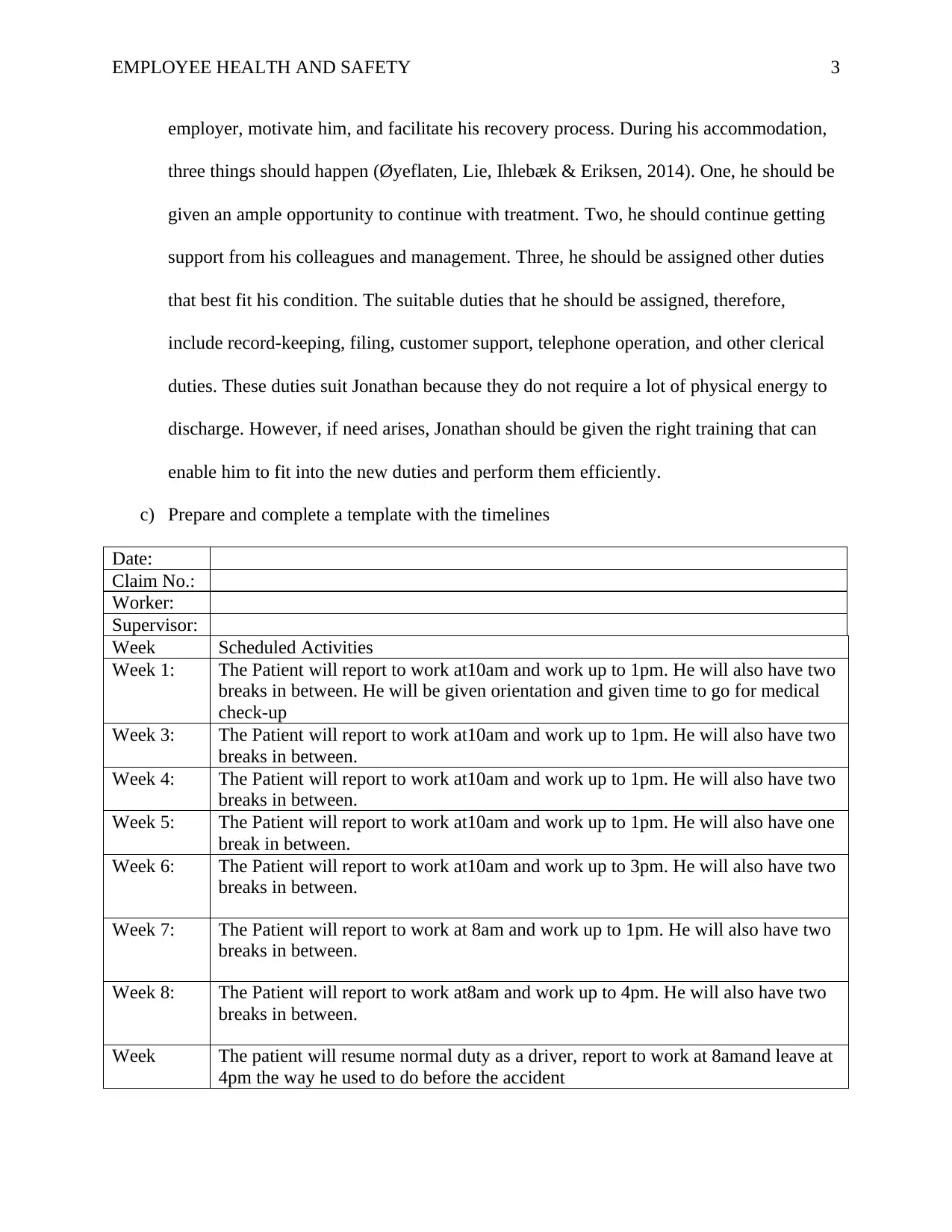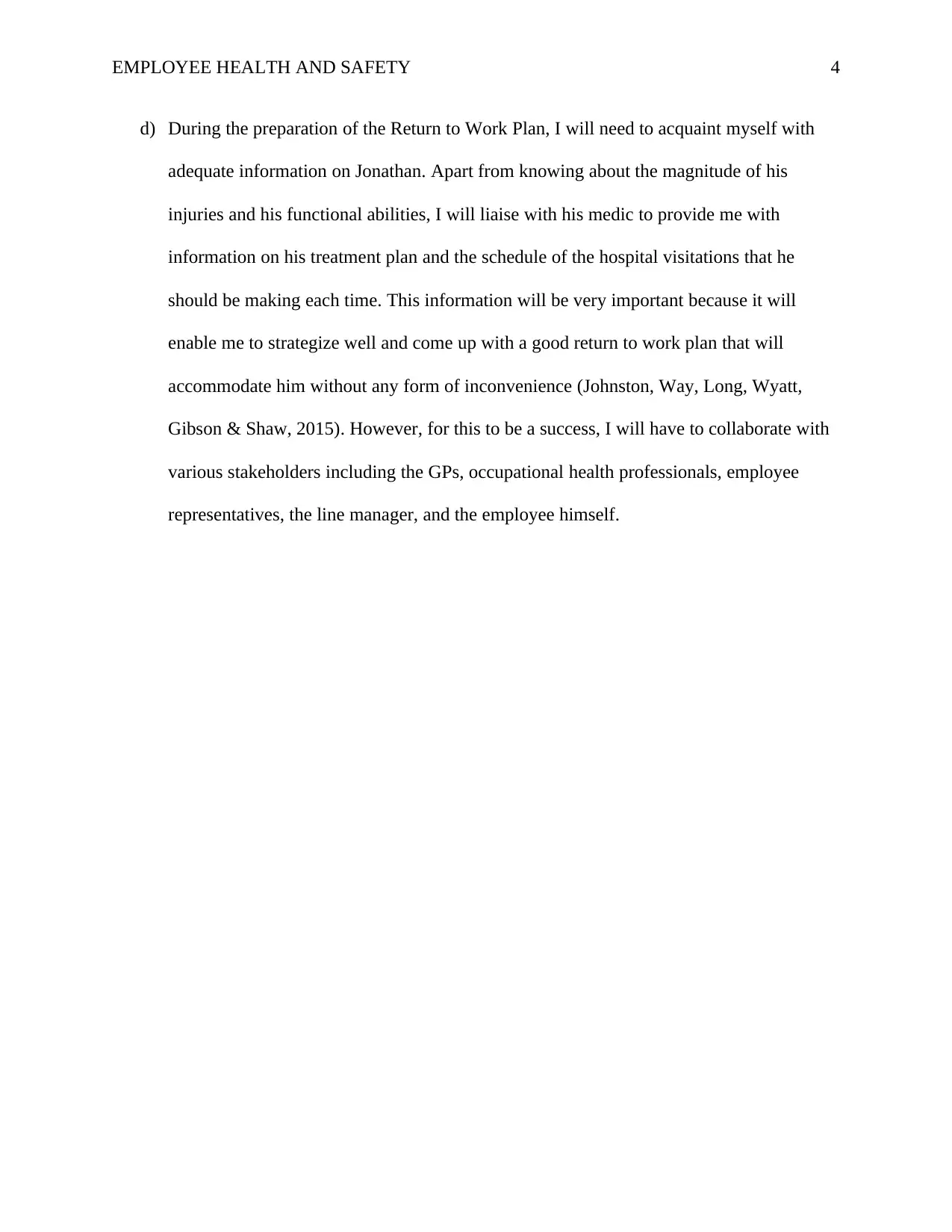Case Study: Crafting an Employee Return to Work Plan Strategy
VerifiedAdded on 2023/06/11
|5
|1078
|96
Case Study
AI Summary
This case study examines the development of a return-to-work plan for an employee, Jonathan, who sustained injuries. It discusses accommodating Jonathan in a new role involving record management due to his physical limitations, outlines the importance of rehabilitation and support from colleagues and management, and proposes a phased return-to-work schedule with gradually increasing responsibilities. The plan emphasizes collaboration with healthcare professionals and other stakeholders to ensure Jonathan's needs are met and his recovery is facilitated, ultimately aiming for a smooth transition back to his original duties as a driver.

Running head: EMPLOYEE HEALTH AND SAFETY 1
Employee Health and Safety
Name
Institution
Employee Health and Safety
Name
Institution
Secure Best Marks with AI Grader
Need help grading? Try our AI Grader for instant feedback on your assignments.

EMPLOYEE HEALTH AND SAFETY 2
Employee Health and Safety
Question 5: Return to Work Plan
a) During his accommodation process, Jonathan would be expected to serve in a new
position. The information from his functional ability assessment revealed that he is not
able to continue serving in his earlier position because of the injury. Therefore, the job
that is recommended to him is record management. The position of record management is
available at Joe Shirts because of the nature of activities that the company engages in. this
is the most suitable duty for Jonathan because his current condition cannot allow him to
serve as a driver or delivery personnel. However, he can comfortably serve in the
proposed position since he can manage it even though he had suffered serious injuries in
his fractured ankles and soft tissues which were damaged (Durand, Corbière, Coutu,
Reinharz & Albert, 2014). The benefit of record management is that is an office and
clerical job that does not require prolonged standing or sitting down that he had been
found to be incapable of doing during his rehabilitation. Meaning, it is a lighter duty that
Jonathan can perform in his current condition especially if he gets adequate support from
his team members and seniors.
b) Before his injury, Jonathan was comfortable to serve the organization in his capacity as a
driver and delivery staff. These are duties that he discharged with ease because he was in
a good state of health. However, all thee changed after the accident in which he suffered
soft tissue damages and ankle injuries. Therefore, the type of accommodation that he
deserves at the moment is rehabilitation. As he continues with his treatment, Jonathan
should not be allowed to stay at home or relocated to any other host employer. Instead, he
should be assigned other suitable duties because it can restore his confidence in the
Employee Health and Safety
Question 5: Return to Work Plan
a) During his accommodation process, Jonathan would be expected to serve in a new
position. The information from his functional ability assessment revealed that he is not
able to continue serving in his earlier position because of the injury. Therefore, the job
that is recommended to him is record management. The position of record management is
available at Joe Shirts because of the nature of activities that the company engages in. this
is the most suitable duty for Jonathan because his current condition cannot allow him to
serve as a driver or delivery personnel. However, he can comfortably serve in the
proposed position since he can manage it even though he had suffered serious injuries in
his fractured ankles and soft tissues which were damaged (Durand, Corbière, Coutu,
Reinharz & Albert, 2014). The benefit of record management is that is an office and
clerical job that does not require prolonged standing or sitting down that he had been
found to be incapable of doing during his rehabilitation. Meaning, it is a lighter duty that
Jonathan can perform in his current condition especially if he gets adequate support from
his team members and seniors.
b) Before his injury, Jonathan was comfortable to serve the organization in his capacity as a
driver and delivery staff. These are duties that he discharged with ease because he was in
a good state of health. However, all thee changed after the accident in which he suffered
soft tissue damages and ankle injuries. Therefore, the type of accommodation that he
deserves at the moment is rehabilitation. As he continues with his treatment, Jonathan
should not be allowed to stay at home or relocated to any other host employer. Instead, he
should be assigned other suitable duties because it can restore his confidence in the

EMPLOYEE HEALTH AND SAFETY 3
employer, motivate him, and facilitate his recovery process. During his accommodation,
three things should happen (Øyeflaten, Lie, Ihlebæk & Eriksen, 2014). One, he should be
given an ample opportunity to continue with treatment. Two, he should continue getting
support from his colleagues and management. Three, he should be assigned other duties
that best fit his condition. The suitable duties that he should be assigned, therefore,
include record-keeping, filing, customer support, telephone operation, and other clerical
duties. These duties suit Jonathan because they do not require a lot of physical energy to
discharge. However, if need arises, Jonathan should be given the right training that can
enable him to fit into the new duties and perform them efficiently.
c) Prepare and complete a template with the timelines
Date:
Claim No.:
Worker:
Supervisor:
Week Scheduled Activities
Week 1: The Patient will report to work at10am and work up to 1pm. He will also have two
breaks in between. He will be given orientation and given time to go for medical
check-up
Week 3: The Patient will report to work at10am and work up to 1pm. He will also have two
breaks in between.
Week 4: The Patient will report to work at10am and work up to 1pm. He will also have two
breaks in between.
Week 5: The Patient will report to work at10am and work up to 1pm. He will also have one
break in between.
Week 6: The Patient will report to work at10am and work up to 3pm. He will also have two
breaks in between.
Week 7: The Patient will report to work at 8am and work up to 1pm. He will also have two
breaks in between.
Week 8: The Patient will report to work at8am and work up to 4pm. He will also have two
breaks in between.
Week The patient will resume normal duty as a driver, report to work at 8amand leave at
4pm the way he used to do before the accident
employer, motivate him, and facilitate his recovery process. During his accommodation,
three things should happen (Øyeflaten, Lie, Ihlebæk & Eriksen, 2014). One, he should be
given an ample opportunity to continue with treatment. Two, he should continue getting
support from his colleagues and management. Three, he should be assigned other duties
that best fit his condition. The suitable duties that he should be assigned, therefore,
include record-keeping, filing, customer support, telephone operation, and other clerical
duties. These duties suit Jonathan because they do not require a lot of physical energy to
discharge. However, if need arises, Jonathan should be given the right training that can
enable him to fit into the new duties and perform them efficiently.
c) Prepare and complete a template with the timelines
Date:
Claim No.:
Worker:
Supervisor:
Week Scheduled Activities
Week 1: The Patient will report to work at10am and work up to 1pm. He will also have two
breaks in between. He will be given orientation and given time to go for medical
check-up
Week 3: The Patient will report to work at10am and work up to 1pm. He will also have two
breaks in between.
Week 4: The Patient will report to work at10am and work up to 1pm. He will also have two
breaks in between.
Week 5: The Patient will report to work at10am and work up to 1pm. He will also have one
break in between.
Week 6: The Patient will report to work at10am and work up to 3pm. He will also have two
breaks in between.
Week 7: The Patient will report to work at 8am and work up to 1pm. He will also have two
breaks in between.
Week 8: The Patient will report to work at8am and work up to 4pm. He will also have two
breaks in between.
Week The patient will resume normal duty as a driver, report to work at 8amand leave at
4pm the way he used to do before the accident

EMPLOYEE HEALTH AND SAFETY 4
d) During the preparation of the Return to Work Plan, I will need to acquaint myself with
adequate information on Jonathan. Apart from knowing about the magnitude of his
injuries and his functional abilities, I will liaise with his medic to provide me with
information on his treatment plan and the schedule of the hospital visitations that he
should be making each time. This information will be very important because it will
enable me to strategize well and come up with a good return to work plan that will
accommodate him without any form of inconvenience (Johnston, Way, Long, Wyatt,
Gibson & Shaw, 2015). However, for this to be a success, I will have to collaborate with
various stakeholders including the GPs, occupational health professionals, employee
representatives, the line manager, and the employee himself.
d) During the preparation of the Return to Work Plan, I will need to acquaint myself with
adequate information on Jonathan. Apart from knowing about the magnitude of his
injuries and his functional abilities, I will liaise with his medic to provide me with
information on his treatment plan and the schedule of the hospital visitations that he
should be making each time. This information will be very important because it will
enable me to strategize well and come up with a good return to work plan that will
accommodate him without any form of inconvenience (Johnston, Way, Long, Wyatt,
Gibson & Shaw, 2015). However, for this to be a success, I will have to collaborate with
various stakeholders including the GPs, occupational health professionals, employee
representatives, the line manager, and the employee himself.
Secure Best Marks with AI Grader
Need help grading? Try our AI Grader for instant feedback on your assignments.

EMPLOYEE HEALTH AND SAFETY 5
References
Durand, M. J., Corbière, M., Coutu, M. F., Reinharz, D., & Albert, V. (2014). A review of best
work-absence management and return-to-work practices for workers with
musculoskeletal or common mental disorders. Work, 48(4), 579-589.
Johnston, V., Way, K., Long, M. H., Wyatt, M., Gibson, L., & Shaw, W. S. (2015). Supervisor
competencies for supporting return to work: a mixed-methods study. Journal of
occupational rehabilitation, 25(1), 3-17.
Øyeflaten, I., Lie, S. A., Ihlebæk, C. M., & Eriksen, H. R. (2014). Prognostic factors for return
to work, sickness benefits, and transitions between these states: a 4-year follow-up after
work-related rehabilitation. Journal of occupational rehabilitation, 24(2), 199-212.
References
Durand, M. J., Corbière, M., Coutu, M. F., Reinharz, D., & Albert, V. (2014). A review of best
work-absence management and return-to-work practices for workers with
musculoskeletal or common mental disorders. Work, 48(4), 579-589.
Johnston, V., Way, K., Long, M. H., Wyatt, M., Gibson, L., & Shaw, W. S. (2015). Supervisor
competencies for supporting return to work: a mixed-methods study. Journal of
occupational rehabilitation, 25(1), 3-17.
Øyeflaten, I., Lie, S. A., Ihlebæk, C. M., & Eriksen, H. R. (2014). Prognostic factors for return
to work, sickness benefits, and transitions between these states: a 4-year follow-up after
work-related rehabilitation. Journal of occupational rehabilitation, 24(2), 199-212.
1 out of 5
Your All-in-One AI-Powered Toolkit for Academic Success.
+13062052269
info@desklib.com
Available 24*7 on WhatsApp / Email
![[object Object]](/_next/static/media/star-bottom.7253800d.svg)
Unlock your academic potential
© 2024 | Zucol Services PVT LTD | All rights reserved.
